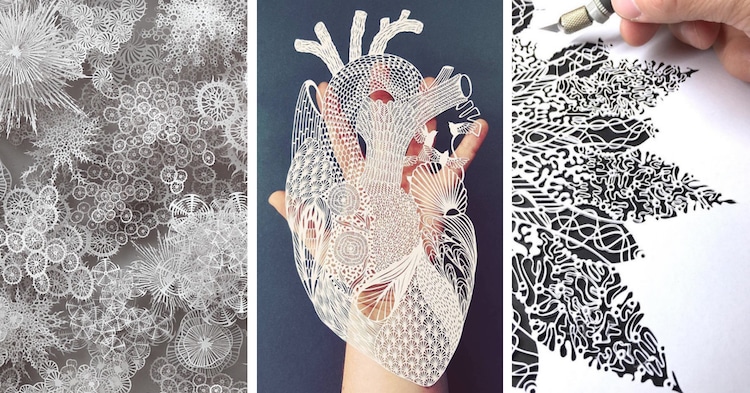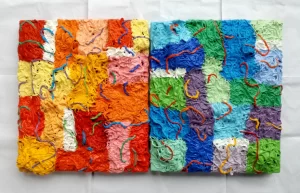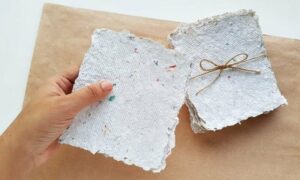The age-old art form of kirigami transforms simple paper into complex shapes and patterns through the careful use of a knife. Originating from various cultures around the world, paper cutting has developed into a respected art form that combines precise cutting techniques with artistic expression. This article is about the art of paper cutting. It tells the story of its long history, methods, modern applications and the appeal of creating intricate works of art with just a single movement.
1. Tapestries of the World: The Long and Interesting History of Paper Cutting
Paper cutting comes from many different cultures around the world and has a long and interesting history. Chinese paper cutting, known as “paper carving,” has a history spanning more than a thousand years and often uses animals and flowers as symbols. In Jewish customs, paper cutting is an important part of religious rituals. In the Polish art style of Wycinanki, the designs are clear and based on folk art. From the Mexican Paper Picado to the German Schellenschnitt, each association has brought its own style and themes to the world of decoupage.
2. Working Tools: Sharp Knives and Scissors
To achieve fine properties when cutting paper, you need very precise tools. Small scissors with sharp blades and precision knives with fine blades are examples of traditional tools. The tools used depend on the difficulty of the design and the artist’s comfort level with using them. Modern paper cutters can also use motors with pre-programmed modes to save time, but traditionalists generally prefer the controls that come with using hand tools.
3. Cutting Paper: The Basics
The artist’s skill and vision determine how simple or complex the paper cut design will be. A commonly used method is tangent, where shapes are cut from paper. The other is a negative crop, where the background is cropped to reveal the design. When artists combine these methods, they can create the layered, deep and intricate designs of kirigami.
4. Themes and Topics:
The themes of paper cutting are often drawn from nature, culture and cultural symbols. Geometric patterns, scenes from everyday life, plants and animals are common themes. When people from different cultures cut paper, they use small shapes and symbols to tell stories. Artists can also combine modern themes and use bold and new patterns to break the boundaries of traditional paper cutting.
5. Contemporary Applications:
Paper cutting originated as a custom but also has a place in modern art, design and other fields. Decoupage is a flexible art form that allows you to create anything from a simple wedding card to a large installation. By giving a centuries-old craft a modern context, artists can make a social or political statement with paper cutting. It is very popular because it can be applied to many different creative areas.
6. Wycinanki: Polish Paper-Cutting Art
Wycinanki is a traditional Polish form of paper cutting known for its bright colors and intricate patterns. Folk themes, floral patterns and symbolic images are carefully cut and combined, often to decorate walls or for traditional events. Wycinanki is a great example of how artistic expression and cultural traditions come together in the world of kirigami.
7. Paper Cutting as a Way to Relax:
Besides being beautiful, paper cutting is also a relaxing activity for artists. Editing again and again, paying close attention to small details and getting lost in the creative process make it a relaxing and healing activity. Many people who cut paper find comfort in the steady motion of the blade, making it a form of awareness similar to meditation.
8. How to Ensure the Safety of Paper Cutting:
To keep decoupages in good condition, they must be handled with care and external factors must be taken into account. By placing your decoupages behind UV-resistant glass, you prevent them from discoloring in the sun. If items are stored properly in acid-free materials, they will not yellow or break down over time. Artists and buyers can guarantee the longevity of these fragile works of art by following conservation guidelines.
Conclusion:
Due to their historical importance and wide range of global expressions, paper cutting remains of interest to artists and art lovers. The precision required to turn a blank sheet of paper into a work of art shows the skill, patience and imagination that go into this age-old craft. Decoupage demonstrates the enduring appeal of precise paper, whether people are trying to keep cultural practices alive, explore modern themes, or find peace through meditation.
FAQs:
1. What is the origin of paper cutting? How has it evolved in different cultures?
Paper cutting has many origins: Chinese paper cutting, Jewish tradition, and Polish Wisnanki paper cutting all contribute unique styles. It has evolved over centuries and reflects cultural stories and artistic expressions around the world.
2. What are the essential tools for decoupage, and how does an artist choose between traditional scissors, precision knives and electric cutting machines?
Basic tools include small scissors, precision knives and, in modern environments, electric cutters. The choice depends on the complexity of the design and the artist’s preference for manual operation or automatic precision.
3. Can you explain basic decoupage techniques and how artists use positive and negative decoupage to create complex designs?
Basic decoupage techniques include forward cuts (cutting out shapes) and negative cuts (cutting out backgrounds) to create deep and complex patterns. Artists combine these techniques to achieve the desired level of detail in their designs.
4. How is paper cutting used today? In what ways do artists use cutouts outside of traditional forms, such as wedding invitations or large-scale installations?
Decoupage has been adapted for contemporary applications, from wedding invitations to large-scale installations. The artist explores social and political themes, making it a versatile medium that is valued in various creative fields.
5. What is the significance of the Polish paper-cutting tradition of Wycinanki? How does it demonstrate the integration of artistic expression and cultural heritage?
Wycinanki is a Polish paper-cutting tradition known for its bright colors and intricate designs. It depicts folk patterns and cultural symbols and embodies the fusion of artistic expression in the field of paper cutting with Poland’s rich cultural heritage.


